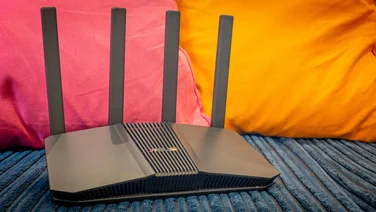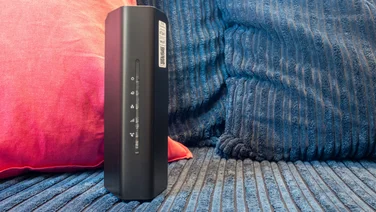To help us provide you with free impartial advice, we may earn a commission if you buy through links on our site. Learn more







- Excellent range and performance
- 10GbE wired networking
- Good software features
- Overkill for many environments
If you want the very fastest wireless connection, Wi-Fi 6E is the way to go. It works on the recently licensed 6GHz frequency band, which is less affected by interference and contention than a regular 5GHz network, meaning fewer lost packets and more megabytes per second. The catch is that it needs 6E-compatible clients: older Wi-Fi 6 devices won’t get any advantage from a Wi-Fi 6E router.
The TP-Link Deco XE200 mesh addresses this with a sensible approach. It sticks with standard 5GHz Wi-Fi 6 for device connections, while using a separate 6GHz network for backhaul communications. This ensures a strong, fast connection between mesh stations, enabling them to provide a good service for all clients over a wide area. It’s an expensive setup but it works very well, making this mesh ideal for anyone who demands uncompromising Wi-Fi performance.
READ NEXT: These are the best mesh Wi-Fi systems to buy right now
TP-Link Deco XE200 mesh review: What you need to know
The standard Deco XE200 package barely qualifies as a mesh at all, comprising just two stations. They’re well specified, though: TP-Link claims that together they’ll cover an area of up to 600m2 and can handle networks of more than 200 client devices.
Quoted speeds are impressive, too. The legacy 2.4GHz radio supports data rates of up to 1,148Mbits/sec – twice as fast as most routers – while the 5GHz and 6GHz bands each go up to a massive 4,804Mbits/sec. And thanks to 8×8 MU-MIMO, all of that bandwidth can be used at once, across two or more compatible clients.

Wired networking is equally well covered. Although each Deco unit only has three Ethernet sockets, one of these is a 10GbE connector, providing options for ultra-fast wired connectivity.
It’s worth noting that there are no USB sockets anywhere, so you can’t use the Deco XE200 to share files over your network. And, as I’ve mentioned, the 6GHz network is reserved for backhaul, so any 6E-enabled devices you may own will fall back to the 5GHz band. You can optionally enable 6GHz client connections but this eats into the airtime available for station-to-station traffic, reducing bandwidth for everyone.
TP-Link Deco XE200 mesh review: Price and competition
Costing £600 for two stations, the Deco XE200 is one of the most expensive mesh systems we’ve seen. Most people don’t need to pay anywhere near this much for whole-home coverage: the Mercusys Halo H80X is a fine Wi-Fi 6 mesh that can currently be had for just £95 with two nodes, or £135 with three. Asus’ ZenWiFi XD5 is a little pricier at £210 for a twin-pack, but comes with useful network security and parental control features.
If you’re looking for high-end performance, you might alternatively consider the Netgear Orbi RBK763. That’s one of the fastest Wi-Fi 6 meshes we’ve tested, and while it was very costly at launch, you can now get a two-station set for a fairly reasonable £340.

Beyond that you’re into the realm of Wi-Fi 6E meshes. The Google Nest WiFi Pro comes in at £380 for three units, although its performance in our tests was disappointing. TP-Link’s Deco XE75 achieves better speeds for the same price, using the same approach as the XE200 and using the 6GHz band for backhaul. The Deco XE75 costs £340.
At the top of the tree, the Netgear Orbi RBKE963 remains the ultimate Wi-Fi 6E mesh. This quad-band system has a dedicated 5GHz backhaul radio in addition to client-facing 2.4GHz, 5GHz and 6GHz transceivers, giving it massive bandwidth to keep traffic racing around your network. The drawback is the eye-widening price – we’re talking £1,200 for the two-node bundle, or £1,700 for a three-pack.
READ NEXT: These are the best Wi-Fi routers to buy today
TP-Link Deco XE200 mesh review: Design and features
The Deco XE200 units have a distinctive upright design. They look a lot like TP-Link’s (now discontinued) Deco X90 stations, but are even bigger, looming 241mm tall and flaring out to a maximum diameter of 130mm across the top.
There are no user controls at all; the only indication that each unit is powered on and working is a multicoloured status LED set into the bottom of the flange. The power socket is hidden on the underside, while the three Ethernet sockets sit in a row at the rear. The bottom one supports 10Gbits/sec over regular Cat6 copper cable; it’ll also happily work with regular gigabit, 2.5GbE or 5GbE connections, so whatever wired hardware you have, the XE200 is ready to make the most of it. You can also use this port for a multi-gigabit internet connection, if you’re lucky enough to have one.

Setup and management are handled by the familiar TP-Link Deco mobile app. There is a browser portal, too, but this serves only as an information dashboard and doesn’t let you make any changes. That’s not a problem, since the app is fairly easy to get around; you can check and tweak your network and wireless settings in a few taps, set up things like port forwarding and address reservation and nominate high-priority clients.
One particularly nice feature is the ability to route individual clients through a third-party VPN gateway. TP-Link’s implementation isn’t as versatile as Asus’ VPN Fusion tool. It only supports one server connection at once and only works with OpenVPN, PPTP and L2TP/IPSec servers, whereas the Asus system supports up to 16 connections and works with WireGuard. Still, the Deco’s VPN support will be fine for most people – it’s a definite plus point.

The app also incorporates TP-Link’s HomeShield services, which cover security and parental controls. The tools provided can scan your network for vulnerabilities and isolate infected clients from the rest of the network; for kids’ devices, you can set a bedtime and block various categories of website. It’s a decent freebie but if you want the full set of features (such as malicious content filtering and configurable time limits) you’ll have to cough up an extra £53.99 a year for a HomeShield Pro subscription. That sticks in the throat a little when you’ve already paid so much for the hardware.
The Deco app also includes a hub for controlling smart home devices. You can create shortcuts to control appliances with a tap, or set up automation routines that trigger at set times, or in response to network events. It’s neat as far as it goes but it can only control TP-Link’s Tapo and Kasa devices, plus Philips Hue lights – so if you’re using a mixture of smart devices from multiple manufacturers it may not be all that useful.
TP-Link Deco XE200 mesh review: Performance
I tested the Deco XE200’s performance twice – once in its default configuration, with the 6GHz radio reserved for backhaul traffic, and then again with Wi-Fi 6E opened up for client connections.
In both cases I used my usual test laptop, with an Intel AX210 Wi-Fi 6E network card (supporting 2×2 MIMO) to copy files to and from an Asustor Drivestor 4 Pro NAS appliance, which was connected to the XE200 via 2.5GbE. Here are the speeds I saw in various parts of my home over the 5GHz network, along with results from some other mesh systems:


It’s a pretty unanswerable performance. Even in the furthest reaches of my home the XE200 delivered exceptional download speeds. It was more than twice as fast as basic dual-band meshes such as the Asus ZenWiFi XD5 and the Mercusys Halo H80X, and easily outpaced pricier rivals such as the Deco XE75, the Google Nest WiFi Pro and the Netgear Orbi RBK762. Even Netgear’s top-shelf Orbi RBKE963 couldn’t match the performance enabled by the XE200’s ultra-high-bandwidth 8×8 backhaul connection.
When I enabled 6E client connections and repeated the test on the 6GHz band, the XE200 didn’t fare so well:


Same-room download speeds over 6GHz were fantastic, and Deco XE200 was overall still faster than Google’s 6E mesh (although, curiously, a little slower than the Deco XE75). In most locations, though, using the 6GHz connection slowed things down. By contrast, the Orbi RBKE963’s quad-band design allowed it to make full use of the 6GHz band all over the house, and deliver consistently strong performance.
I should also mention that the XE200 units are also unusually power hungry. I measured an idle power draw of 20.6W from each one, which rose to 24.3W during my file-copy tests. The RBKE963 units drew only 13.4W when idle, while the lightweight Asus ZenWiFi XD5 stations sucked up just 6.2W.
READ NEXT: These are the best wireless extenders to buy
TP-Link Deco XE200 mesh review: Verdict
If you’re the sort of person who gets excited about the latest and greatest wireless networking technologies, the Deco XE200 might feel like a bit of a letdown. By default, it won’t connect to your Wi-Fi 6E devices on the 6GHz band and, if you manually configure it to do so, you actually lose performance. But so what? The key thing to know about the Deco XE200 is that it delivers faster downloads on the 5GHz band than competing routers and meshes manage over 6GHz.
This doesn’t necessarily mean you should rush out and spend the £600. In fact, we’d recommend most people don’t. The Mercusys Halo H80X has enough bandwidth to handle half a dozen video streams, Zoom calls and downloads for less than a quarter of the price. There’s no need for most homes or offices to spend more.
If you’re seriously looking for the fastest, farthest-reaching Wi-Fi around, however, the TP-Link Deco XE200 is a terrific choice. It’ll deliver enormous speeds throughout your home for half the price of Netgear’s Orbi system and all your devices can reap the benefits, even if they don’t support Wi-Fi 6E.






